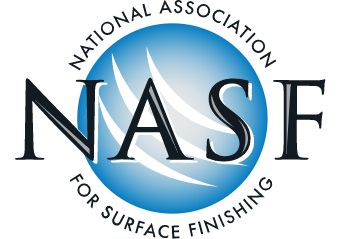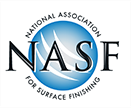NASF Public Policy Update | January 2021
The National Association for Surface Finishing (NASF) offers its public policy update for January 2021 to the finishing industry.

The National Association for Surface Finishing (NASF, Washington, D.C.) has released its Public Policy update for January 2021. NASF regularly releases public policy updates for its members, but this ipdate is being made available to the larger finishing industry. Anyone can access the full NASF January 2021 Public Policy Update here.
Here are some highlights:
The incoming Biden administration and Georgia runoff election may shift environmental policy and chemicals policy (including PFAS regulation). NASF suspects environmental justice and climate change will be at the top of the agenda, as well as new initiatives on the labor, health and safety, tax, trade and other fronts.
The EPA has released updated 2019 Toxics Release Inventory (TRI) data that includes summary and trend information, but does not include EPA's full analysis of the 2019 data. The 2019 TRI National Analysis, to be published in early 2021, will examine different aspects of the data, including trends in releases, other waste management practices, and pollution prevention activities.
In March 2020, the EPA published its proposed 2020 National Pollutant Discharge Elimination System (NPDES) Multi-Sector General Permit (MSGP) that authorizes stormwater discharges associated with industrial activity in areas where EPA is the NPDES permitting authority. NASF has submitted comments on the proposed MSGP.
The EPA identified n-propyl bromide (1-bromopropane) as one of its first ten high priority chemicals under the Toxic Substances Control Act (TSCA). N-propyl bromide is used as a solvent to clean parts prior to surface finishing. EPA has one year from the risk evaluation to issue a proposed rule and two years from the risk evaluation to issue a final rule. NASF as well as a few of its members have been invited to participate in the Small Business Regulatory Enforcement Fairness Act (SBREFA) panel as small entity representatives (SERs).
EPA has also identified trichloroethylene (TCE) as one of its first ten high priority chemicals under the Toxic Substances Control Act (TSCA). TCE has been used as a solvent to clean parts prior to surface finishing.
NASF, with the assistance of Dr. Janet Anderson, developed a PFAS Sampling and Analysis Plan (SAP) for NASF members.
In 2020, the EPA proposed a regulatory determination to regulate PFOS and PFOA in drinking water. This is the first step in the regulatory process to establish a federal drinking water standard for PFOS and PFOA. NASF has encouraged the EPA to consider a treatment-focused regulatory approach to a drinking water standard for PFOS and PFOA, and that the treatment technologies considered must be technologically and economically feasible, consistent with the SDWA.
In 2020, the EPA issued a final significant new use rule (SNUR) for long-chain perfluoroalkyl carboxylate (LCPFAC) chemical substances that imposes notification and other regulatory requirements on the manufacture, import or processing of certain new uses of specified LCPFAC substances, including PFOA and its salts. This SNUR does include PFOS or 6:2 FTS, the substances used in fume suppressants in the surface finishing industry. Accordingly, the article exemption for PFOS and 6:2 FTS would not be impacted by this SNUR.
EPA has published the draft Interim Guidance on Destroying and Disposing of Certain PFAS and PFAS-Containing Materials That Are Not Consumer Products with a 60-day public comment period under docket EPA-HQ-OLEM-2020-0527.
EPA Region 5, EPA Office of Research and Development (ORD) and the Michigan Department of Environment, Great Lakes and Energy (EGLE) conducted PFAS testing of fume suppressants currently in use and effluent discharge at approximately 12 plating shops in Michigan. The goal of this project was to determine if any PFOS is present in the fume suppressant currently in use and which PFAS, if any, may be in the effluent discharges of finishing shops.
On September 24, 2020, the Michigan Department of Environment, Great Lakes, and Energy (EGLE), Air Quality Division issued an initial threshold screening level (ITSL) for air emissions of 6:2 fluorotelomer sulfonate (or 6:2 FTS) of 1 μg/m³, with annual averaging time. 6:2 FTS is used in the current formulations of fume suppressants for chrome plating applications.
NASF and the AESF Foundation have joined the Water and Environmental Technology (WET) Center Industrial Advisory Board, which focuses on a broad range of water and wastewater technologies and related public health issues.
To get more information on any of the stories mentioned above, access the full NASF Public Policy Update for January 2021.
 This article is courtesy of the Products Finishing and National Association for Surface Finishing (NASF) media partnership. For more information or to become a member, visit nasf.org.
This article is courtesy of the Products Finishing and National Association for Surface Finishing (NASF) media partnership. For more information or to become a member, visit nasf.org.
Related Content
Take Full Advantage of Industry Events
As travel plans ramp up for the year, what industry events will you attend? Products Finishing offers a quick look at some of the upcoming opportunities for 2024.
Read MoreHighlights from SUR/FIN 2023
Products Finishing offers a recap of some of the topics that were top of mind at the SUR/FIN 2023 finishing industry trade show.
Read MoreLooking Back: The Columnists
Many industrial/technical journals consist of a well-rounded mixture of technical papers, practical articles about technology and how-to-do-it features, including this one, Products Finishing. In its decades of publication, the AESF/NASF journal, Plating & Surface Finishing also endeavored to meet this need. Among the many features were those of the columnists, recognized experts who had expertise in certain segments of the surface finishing industry. This article contains a sampling of columns published in P&SF over the years, which still retain information of importance even today.
Read MoreNASF/AESF Foundation Research Project #120: Electrochemical Destruction of Perfluorooctanesulfonate in Electroplating Wastewaters – January – December 2023
This NASF-AESF Foundation research project report covers quarterly reporting for the year 2023 at the University of Illinois at Chicago. The objective of this work is to utilize a cost-effective reactive electrochemical membrane (REM) for the removal of PFAS from synthetic electroplating wastewater. Discussed here are the oxidation of PFOA with three different catalysts, development of a method for detecting PFAS, as well as work on 6:2-fluorotelomersulfonic acid (6:2 FTS) and electrodeposited bismuth/tin oxide catalysts.
Read MoreRead Next
Education Bringing Cleaning to Machining
Debuting new speakers and cleaning technology content during this half-day workshop co-located with IMTS 2024.
Read MoreA ‘Clean’ Agenda Offers Unique Presentations in Chicago
The 2024 Parts Cleaning Conference, co-located with the International Manufacturing Technology Show, includes presentations by several speakers who are new to the conference and topics that have not been covered in past editions of this event.
Read MoreDelivering Increased Benefits to Greenhouse Films
Baystar's Borstar technology is helping customers deliver better, more reliable production methods to greenhouse agriculture.
Read More

























